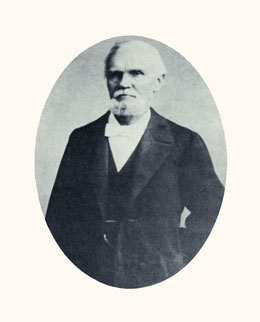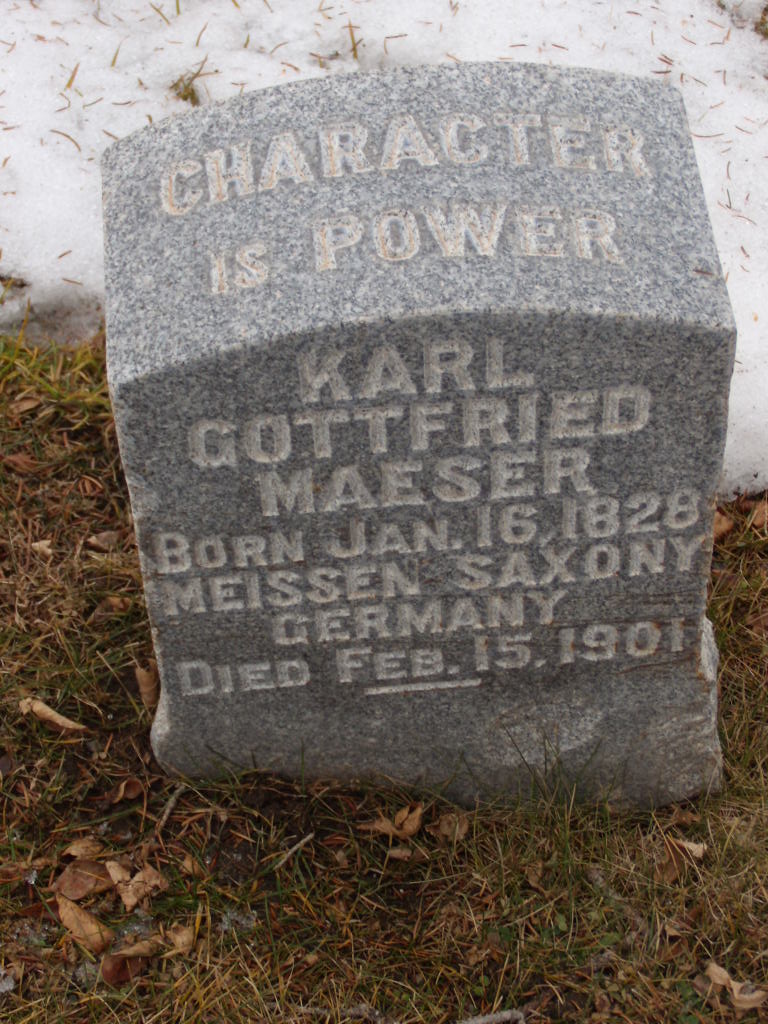Difference between revisions of "Karl G. Maeser"
(→Life) |
|||
| Line 40: | Line 40: | ||
Karl G. Maeser was born, raised and educated in Meissen. Now, as a result, the two cities share a sister-city relationship. The connection between Provo and Meissen through Maeser was the original inspiration for the sister-city partnership. It is the hope of both cities that the relationship will grow to include the exchange of delegations, including manufacturers, youth, academicians, scientists, artists, associations, clubs, tourists, technicians and others, which will result in enriching the cultures of the respective cities. As of 2001 the two cities have been sending high school age students on a three week long exchange to gain more knowledge about their differences in society and culture.<ref>[http://www.provo.org/econdev.Official_Agreement_main.html City of Provo, Utah ::<!-- Bot generated title -->]</ref><ref>http://www.provo.org/img-imported/Mayor-Billings-at-a-table2.jpg</ref> | Karl G. Maeser was born, raised and educated in Meissen. Now, as a result, the two cities share a sister-city relationship. The connection between Provo and Meissen through Maeser was the original inspiration for the sister-city partnership. It is the hope of both cities that the relationship will grow to include the exchange of delegations, including manufacturers, youth, academicians, scientists, artists, associations, clubs, tourists, technicians and others, which will result in enriching the cultures of the respective cities. As of 2001 the two cities have been sending high school age students on a three week long exchange to gain more knowledge about their differences in society and culture.<ref>[http://www.provo.org/econdev.Official_Agreement_main.html City of Provo, Utah ::<!-- Bot generated title -->]</ref><ref>http://www.provo.org/img-imported/Mayor-Billings-at-a-table2.jpg</ref> | ||
| − | [[Image: | + | [[Image:Karl_G_Maeser_grave.jpg|right|thumb|200px|Karl G. Maeser's grave marker]] |
== Song to his memory == | == Song to his memory == | ||
Revision as of 22:05, 10 June 2019
Karl Gottfried Maeser (January 16,1828 – February 15,1901) was a prominent Utah educator and a member of The Church of Jesus Christ of Latter-day Saints (LDS Church). He is most famous for having served 16 years as principal of Brigham Young Academy, now Brigham Young University (BYU), where he is seen as the true founder of the institution.[1]
A Native of Saxony, Maeser served as a missionary for the church in four nations and held many leadership positions in the church, including serving as the head of the Church Educational System and in the central leadership of the Sunday school.
Contents
Life
Born in Meissen, Germany, Maeser attended parochial school as a boy.[2] By 1855 Maeser was a teacher at the Budich Institute in Dresden. He joined The Church of Jesus Christ of Latter-day Saints in Dresden. He was baptized by William Budge. At this time all Latter-day Saints were urged to gather together in Utah. Maeser and his family began the journey towards Utah, but in England he was called to serve as a missionary, serving both there and in Scotland, and delaying their journey to Utah.[3] Maeser then immigrated to the United States in 1856. After coming to the United States Maeser served as a missionary in Virginia, where he also did various jobs to earn a living, including teaching music students. Among Maeser's students in Virginia were the daughter's of former United States President John Tyler.[4] Maeser arrived in Utah Territory on September 1st, 1860.In 1860 Maeser was appointed to head the church meetings in Salt Lake City held in the German language. However shortly after this, most of the Swiss Church members moved to Santa Clara, Utah and other locations in southern or central Utah, so the meetings in Salt Lake City were ended. In 1870 there were again enough German speaking church members in Salt Lake City for them to hold their own church meetings, and Maeser was again the one who presided at these meetings.[5]
In his early days in Utah Maeser served as the tutor for Brigham Young's children, but also instructed other children who came to the Young household for this purpose including Ellis Reynolds Shipp.[6]
In 1876, Maeser became the second principal of Brigham Young Academy in Provo, Utah, which was later to become Brigham Young University.[7] He was the first superintendent of the Church Educational System from 1888 to 1901.
Once, during some difficult times as the school was struggling, Maeser pondered going elsewhere. He had a dream, or what he called a vision in which he saw "Temple Hill filled with buildings - great temples of learning."[8]
A moving story comes from when the old Lewis building where the academy first met burned down. Reed Smoot, a former student of Maeser's approached him and said "Dr. Maeser, the academy is no more." Maeser responded "no such thing, the building has burned but the academy lives on in us."
For a short period of time Maeser was an assistant organist for the Mormon Tabernacle Choir (now known as the Tabernacle Choir at Temple Square).[9] For a time he was the mission president over the German Mission of the church. In 1869 Maeser began publication of a Church periodical while sering as a missionary in Switzerland.
Maeser was married twice, first to Anna Mieth in 1854, and then in 1875 to Emilie Damke as a plural wife.
Brigham Young Academy
When Maeser arrived at Brigham Young Academy in 1876 it was dying. Enrollment had declined since Warren N. Dusenberry had started the school a few months before. There were only 29 students at the time of Maeser's arrival.[10]
Maeser believed that "Come follow me" and not "Thou Shalt" was the best principal for teaching. [11]
Maeser had a profound effect on his students. One of them, Alice Louise Reynolds wrote "He had the ability to inspire. He made his students feel the worth of life; he told us that the Lord had sent each of us to do a special work, and that the proper preparation was necessary for that mission."[12]
Among the students who studied under Maeser were Reed Smoot, George Sutherland, William H. King,[13]Alice Louise Reynolds, William Spry,[14] Bryant S. Hinckley, and James E. Talmage.
California missionary work
In the mid-winter fair in San Francisco in 1893-1894, Maeser had charge of the Utah exhibit. Although this was largely to create interest in Utah, that state and the church were so intertwined that advancing one advanced the other. Maeser and his associates rented a hall in which church members held meetings along with new friends they had developed through the Utah exhibit. This was a key component behind the organization of the California Mission of the church. Maeser presided over this mission until August 1894 when he was replaced by Henry S. Tanner as president.[15]
Superintendent of the Church Educational System
In 1892 Maeser was made the superintendent of the Church Educational System.
During this same time Maeser served in the General Superientendency of the Deseret Sunday School Union. He was the Second Assistant to General Superientendent George Q. Cannon from July 1894 to January 1899. He then served as the First Assistant to Cannon from January 1899 until February 1901.[16]
Meissen
Karl G. Maeser was born, raised and educated in Meissen. Now, as a result, the two cities share a sister-city relationship. The connection between Provo and Meissen through Maeser was the original inspiration for the sister-city partnership. It is the hope of both cities that the relationship will grow to include the exchange of delegations, including manufacturers, youth, academicians, scientists, artists, associations, clubs, tourists, technicians and others, which will result in enriching the cultures of the respective cities. As of 2001 the two cities have been sending high school age students on a three week long exchange to gain more knowledge about their differences in society and culture.[17][18]
Song to his memory
A poem turned song was written in his memory. The words were written by Annie Pike Greenwood, with the music by L.D. Edwards. It is titled "Come, Lay His Books and Papers by." This song became an LDS hymn and appeared in the 1948 edition of the hymn book as hymn #338. After the title it states "In memory of Dr. Karl G. Maeser." It is not included in the 1985 hymn book.
Quotes
"I have been asked what I mean by my word of honor. I will tell you. Place me behind prison walls-- ever so high, ever so thick, reaching ever so far into the ground - there is a possibility that in some way or another I will escape; but stand me on a floor and draw a chalk line around me and have me give my word of honor never to cross it. Can I get out of the Circle? No. Never! I would die first."[19]
"The fear of the Lord is the Beginning of Wisdom. This life is one great object lesson to practice on the principles of immortality and eternal life. Man grows with his higher aims. Let not that is unholy ever enter here" (written on a chalk board during his Nov. 9th, 1900 visit to Maeser Elementary School in Provo, Utah.)[11]
Notes
- ↑ A search of the BYU website for "Karl Maeser" generates 658 references, such as "BYU's legacy of success dates back to 1876, when Karl G. Maeser began his term as its first permanent principal" (see http://newsnet.byu.edu/story.cfm/43902)
- ↑ Burton. Maeser. p. 2
- ↑ Burton, Alma P., Karl G. Maeser: Mormon Educator (Salt Lake City: Deseret Book Co., 1953) p. v
- ↑ Winder, Michael K., Presidents and Prophets: The Story of America's Presidents and the LDS Church. (Salt Lake City: Covenant Communications, 2007) p. 62
- ↑ Jensen, Richard L., "Mother Tongue: The Use of Non-English languages in the Church in the United States, 1842-1983" in Bitton, Davis and Maureen Ursenbach Beecher, ed., New Views of Mormon History (Salt Lake City: University of Utah Press, 1987) p. 277
- ↑ McCloud, Susan Evans. Brigham Young: A Personal Portrait (American Fork, Utah: Covenant Communications, 1996)
- ↑ History of BY High from 1869 to 1903
- ↑ http://unicomm.byu.edu/about/presidents/maeser.aspx?lms=3
- ↑ The Official Site of the Mormon Tabernacle Choir
- ↑ Wilkinson, Ernest L. Speeches of The Year BYU 1962, p. 2
- ↑ 11.0 11.1 MSE :: Maeser Chalkboards Preserved
- ↑ http://magazine.byu.edu/?act=view&a=172; quoting They Galdly Taught. ed. Jean Anne Waterstradt {Provo: BYU, 1988) vol. 3, p. 132
- ↑ Conference Report, October 1950, p. 32
- ↑ 1962 speechs of the Year, p. 7
- ↑ Jenson, Andrew. Encyclopedic History of the Church of Jesus Christ of Latter-day Saints. Corporation of the President of the Church of Church of Jesus Christ of Latter-day Saints. 1941. p. 109-110.
- ↑ LDS Church Almanac, 2008 Edition, p. 115
- ↑ City of Provo, Utah ::
- ↑ http://www.provo.org/img-imported/Mayor-Billings-at-a-table2.jpg
- ↑ Honor Code - Home
References
- Burton, Alma P. Karl G. Maeser, Mormon educator. Deseret Book Co (1953), 79 pages. ASIN: B0007F29IE
- Maeser, Karl Gottfried. School and Fireside. Skelton (1898), 358 pages. ASIN: B000882GWY
- Maeser, Reinhard. Karl G. Maeser: A biography by his son. Brigham Young University (1928), 184 pages. ASIN: B000893U14
- Hymns- The Church of Jesus Christ of Latter-day Saints. Copyright 1948 by Corporation of the President The Church of Jesus Christ of Latter-day Saints, published 1978 by Deseret Book Company for The Church of Jesus Christ of Latter-day Saints

